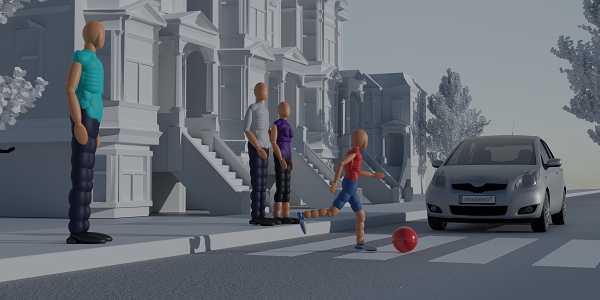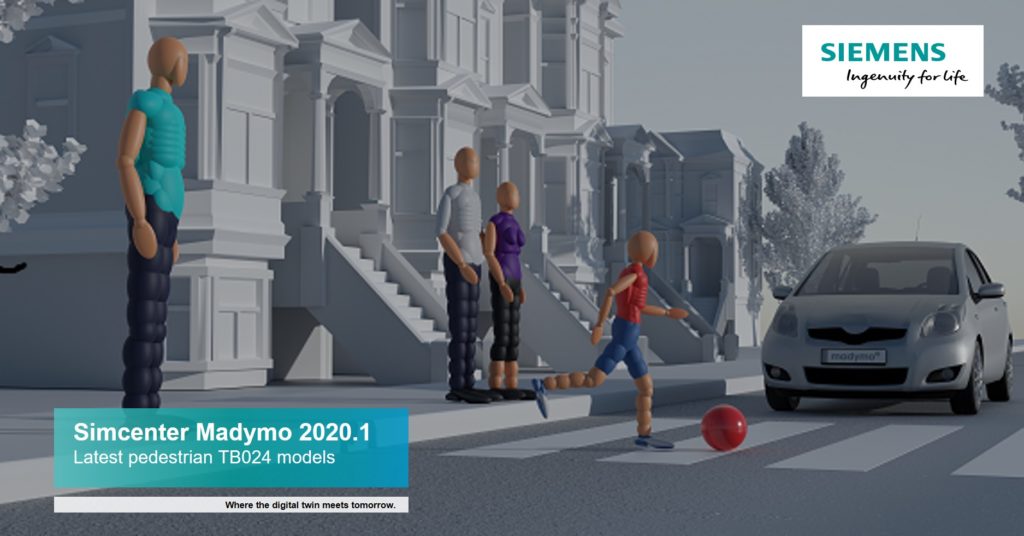Pedestrian safety systems improvement using the latest TB024 dummy models


Pedestrian safety systems design
Have you ever noticed that the engines of modern cars have plastic covers and are overall much flatter than those of a bygone era? This is done for a reason; the plastic covers’ hard ridges and the flat top prevent protrusions through the bonnet/hood when impacted. These features are in essence a part of the vehicle’s safety system. When a car hits a pedestrian, risk of serious injury and potential loss of life can be minimized through the prevention of the load being concentrated on a small area. This is just the visible part, as an extensive program is required to design, test and validate these safety systems. Today these safety systems are required to follow Euro NCAP TB024 guidelines.
With the release of Simcenter Madymo 2020.1, Siemens has introduced a new family of models that are able to validate against TB024 v2.0 certification requirements.
The risk to pedestrians
The design of the car hood is dependent not just on the dimensions of the engine it covers, but is also constrained by aesthetic and aerodynamic considerations. With some car designs, this creates a serious risk to pedestrians, leading to additional safety constraints. When the car impacts a person, the person tends to pivot on the leading edge of the car and rotate; this happens in such a way that the head can hit hard points under the hood, or even strike the car behind the hood or at the base of the windscreen.
Reducing the risk
The resulting solution was that on impact, the hood is accelerated upwards to prevent or minimize the force of the human head hitting the vehicle hood/bonnet surface.
One solution to minimize this risk for a range of pedestrian sizes is to increase the distance between the hood and hard points of the engine by actively springing the hood upwards upon detecting an impact. This minimizes the force of the human head hitting the vehicle hood/bonnet surface.
This acceleration of the hood on impact as a safety tool has become very common and is now included in the Euro NCAP guidelines. With each new vehicle model, this safety system needs to be validated with pedestrians of numerous sizes and at a variety of speeds. Furthermore, the automotive OEM wants to get the design feature approved early in the development process, with the aim to minimize the risk of having to make major design changes in a later and more critical stage of the model introduction. As a result, many trials need to be run, with a variety of car designs, pedestrian models and vehicle speeds. Ideally, the manufacturer wants to run these tests before production of the first full prototype. Now enter the digital twin; it is only through simulation that such numbers, combinations and variations can be viably investigated.
One very important additional benefit to the automotive safety engineer is that when all these virtual simulations have been carried out, the meticulously recorded test results are valid throughout the safety standard tests and are used in ratings and certification.
Previous safety guidelines
Since 2018, car manufacturers who fulfilled the criteria of Euro NCAP TB013 have been able to show the validation of the hood safety systems by using computer simulation. In a situation where the results of the simulations do not satisfy the guidelines, Euro NCAP resorts to testing the car with the hood safety system turned off, thus increasing the risk that the car will fail the required safety standards.
Updated safety guidelines
Euro NCAP have recently released ‘Technical Bulletin TB024’, in which they have increased the number of guidelines that must be met when using computer simulations. These guidelines cover many subjects including how the Human Body Model (HBM) is run in software. Also reference points used on the HBM, as well as accuracy and repeatability are included. Furthermore, all accepted models must perform the same (within prescribed limits) as the model that is considered the state-of-the-art, specifically when impacted by a range of prescribed vehicle models and at a range of impact speeds. An example is shown in the figure below. The paths of points on the head, chest and hip must remain within the shaded areas of the curves as the model passes over the bonnet/hood of the car.

Tools to help meet the new guidelines
Siemens has recently released Simcenter Madymo 2020.1, introducing a new family of pedestrian models: a large male, mid-sized male, small female and a 6-year-old child that validate to the TB024 requirements. They have the required geometry and response to impacts to validate against the TB024 v2.0 certification requirements. This certification was demonstrated in coupling simulations with both LS-Dyna and Radioss Generic Vehicle models used to impact the Simcenter Madymo pedestrian models. Furthermore, the application models of all collision scenarios are provided in a neat folder structure that supports LS-Dyna and Radioss users when running and evaluating their simulations. With the new release of Simcenter Madymo 2020.1 we have come a step closer to optimizing vehicle pedestrian safety systems and helping to save lives.
Watch the on-demand webinar Pedestrian Safety Systems development and the latest Euro NCAP guidelines to find out how an integrated simulation contributes to pedestrian and occupant safety?
For more information about Occupant Safety Simulation go here.


